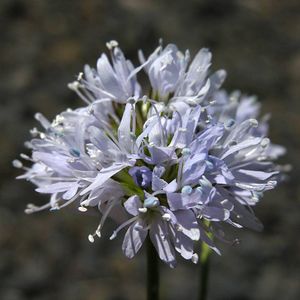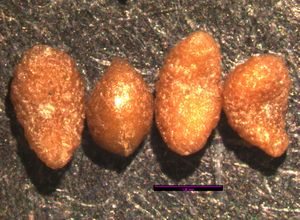Difference between revisions of "Gilia capitata"
(→Distribution) |
|||
| (12 intermediate revisions by 2 users not shown) | |||
| Line 1: | Line 1: | ||
| − | ''' | + | * Scientific Name: ''Gilia'' ''capitata'' |
| − | + | * Family: Polemoniaceae | |
| − | + | * Common Names: bluehead gilia, globe gilia | |
| − | + | * Codon: GILCAP | |
---- | ---- | ||
| − | + | [[File:GILCAP1.jpg |thumb|Photo by Ben Legler, 2004 also featured on Main Page]] | |
| − | + | ===Taxonomy=== | |
| − | + | {{Taxobox | |
| − | + | | name = | |
| − | + | | image = | |
| − | + | | image_alt = Gilia capitata | |
| − | + | | image_caption = Photo by Ben Legler, 2004. Featured on Main Page | |
| − | + | | regnum = [[Plant]]ae | |
| + | | subregnum = Viridiplantae | ||
| + | | phylum = Tracheophyta | ||
| + | | subphylum= Tracheophytina | ||
| + | | classis = Magnoliopsida | ||
| + | | subclassis = Asteranae | ||
| + | | ordo = Ericales | ||
| + | | familia = Polemoniaceae | ||
| + | | genus = ''Gilia'' Ruiz & Pav. | ||
| + | | species = '''''Gilia capitata''''' Sims | ||
| + | | binomial = | ||
| + | | binomial_authority = | ||
| + | | synonyms = | ||
| + | | range_map = | ||
| + | | range_map_alt = | ||
| + | | range_map_caption = | ||
| + | }} | ||
| + | <ref>Integrated Taxonomic Information System. Retrieved from https://www.itis.gov/servlet/SingleRpt/SingleRpt?search_topic=TSN&search_value=31107</ref> | ||
| + | === Description === | ||
| + | Annual herb from a taproot.<ref name=":0">Hitchcock, C. L., Cronquist, A., Giblin, D., & Legler, | ||
| + | B. et al. (2018). ''Flora of the Pacific Northwest: an illustrated manual''. | ||
| + | Seattle: University of Washington Press.</ref> | ||
| − | + | Leaves pinnately lobed, segments and rachis slender, reduced upwards on stem.<ref name=":0" /> Leaf axils and midribs generally hairy.<ref name=":1">Klinkenberg, Brian. (Editor) 2020. ''E-Flora BC: Electronic Atlas of the Plants of'' | |
| − | + | British Columbia'' [eflora.bc.ca]. Lab for Advanced Spatial Analysis,'' | |
| − | + | Department of Geography, University of British Columbia, Vancouver. [Accessed: | |
| + | 2020-06-08 12:03:17 PM ]</ref> | ||
| − | + | Inflorescence terminal, spheric, consisting of many unstalked flowers, generally more than 8 per head, corolla bluish.<ref name=":0" /> Corolla lobes 5, generally about as long as the corolla tube. 5 sepals, membranes white, expanded during fruiting.<ref name=":1" /> Stamens equal as long as or slightly exserted from corolla lobes.<ref name=":0" /> | |
| − | + | Fruits are 3-chambered capsules, each bearing 1-3 seeds.<ref name=":1" /> | |
| + | ---- | ||
| + | ===Bloom Period=== | ||
| − | + | May, June, July<ref>WTU Herbarium, Burke Museum, | |
| − | + | & University of Washington. Retrieved from <nowiki>https://biology.burke.washington.edu/herbarium/imagecollection/photo.php?Photo=wtu057502&Taxon=Gilia%20capitata&SourcePage=taxon</nowiki></ref> | |
| − | + | ||
---- | ---- | ||
| − | + | ===Distribution=== | |
| − | = | + | Mostly west Cascades, southern BC to California occasionally east to western Idaho.<ref name=":0" /> |
---- | ---- | ||
| − | |||
===Habitat=== | ===Habitat=== | ||
| − | |||
| − | |||
| + | Found in open places below 7,000 ft. elevation. West-side forest, meadow, and east-side forest. | ||
| + | Grows in open, sandy, or rocky soils, and grassy hillsides.<ref name=":2">Middleton, Kelsey G. (2011, May 19). | ||
| + | ''Plant Propagation Protocol for Gilia capitiata''. UW Courses: ESRM 412 – | ||
| + | Native Plant Production.</ref> | ||
| + | ---- | ||
===Uses=== | ===Uses=== | ||
| + | |||
| + | Payómkawichum use of seeds as food.<ref>Sparkman, Philip S., 1908, The Culture of the Luiseno Indians, | ||
| + | University of California Publications in American Archaeology and | ||
| + | Ethnology 8(4):187-234, page 230. Retrieved from http://naeb.brit.org/uses/search/?string=gilia+capitata</ref> | ||
| + | |||
| + | Rich nectar source. | ||
---- | ---- | ||
| − | + | ===Propagation=== | |
| − | = | + | Seeds do not require pre-treatment but germination improved by the presence of charred wood or aqueous extracts of it.<ref name=":2" /> |
---- | ---- | ||
| − | + | ===Seed=== | |
| − | |||
| − | |||
'''Seed sample from:''' 2011 | '''Seed sample from:''' 2011 | ||
| Line 52: | Line 81: | ||
====Features==== | ====Features==== | ||
| − | + | [[File:GICA LisaHintz sd 2012.jpg|thumb|Photo by Lisa Hintz]] | |
'''Shape:''' Seed narrow at hilium end, broadening at opposite apex. Hilium inconspicuous. Uniformity in shape is not that common, but most seeds take a relatively teardrop shaped. | '''Shape:''' Seed narrow at hilium end, broadening at opposite apex. Hilium inconspicuous. Uniformity in shape is not that common, but most seeds take a relatively teardrop shaped. | ||
| − | |||
| − | |||
'''Color:''' Seed is brown, very bumpy, and slightly lustrous. | '''Color:''' Seed is brown, very bumpy, and slightly lustrous. | ||
| Line 67: | Line 94: | ||
'''Longitudinal Cross Section:''' obovate [[File:GICA long.png]] | '''Longitudinal Cross Section:''' obovate [[File:GICA long.png]] | ||
| − | + | {{Basics}} | |
---- | ---- | ||
| − | |||
| − | |||
| − | |||
| − | |||
| − | |||
| − | |||
| − | |||
| − | |||
===Photo Gallery=== | ===Photo Gallery=== | ||
| − | |||
<gallery> | <gallery> | ||
| − | File: | + | File:GILCAP2.jpg|Photo by Ben Legler, 2004 |
| − | + | ||
| − | + | ||
| − | + | ||
</gallery> | </gallery> | ||
| + | |||
| + | === References === | ||
| + | ---- | ||
| + | <references /> | ||
Latest revision as of 14:30, 29 June 2021
- Scientific Name: Gilia capitata
- Family: Polemoniaceae
- Common Names: bluehead gilia, globe gilia
- Codon: GILCAP
Contents
Taxonomy
| Scientific classification | |
|---|---|
| Kingdom: | Plantae |
| Subkingdom: | Viridiplantae |
| Phylum: | Tracheophyta |
| Subphylum: | Tracheophytina |
| Class: | Magnoliopsida |
| Subclass: | Asteranae |
| Order: | Ericales |
| Family: | Polemoniaceae |
| Genus: | Gilia Ruiz & Pav. |
| Species: | Gilia capitata Sims |
Description
Annual herb from a taproot.[2]
Leaves pinnately lobed, segments and rachis slender, reduced upwards on stem.[2] Leaf axils and midribs generally hairy.[3]
Inflorescence terminal, spheric, consisting of many unstalked flowers, generally more than 8 per head, corolla bluish.[2] Corolla lobes 5, generally about as long as the corolla tube. 5 sepals, membranes white, expanded during fruiting.[3] Stamens equal as long as or slightly exserted from corolla lobes.[2]
Fruits are 3-chambered capsules, each bearing 1-3 seeds.[3]
Bloom Period
May, June, July[4]
Distribution
Mostly west Cascades, southern BC to California occasionally east to western Idaho.[2]
Habitat
Found in open places below 7,000 ft. elevation. West-side forest, meadow, and east-side forest. Grows in open, sandy, or rocky soils, and grassy hillsides.[5]
Uses
Payómkawichum use of seeds as food.[6]
Rich nectar source.
Propagation
Seeds do not require pre-treatment but germination improved by the presence of charred wood or aqueous extracts of it.[5]
Seed
Seed sample from: 2011
Average Measurement: 1.7 x 1.1 x 0.7
Measurement Range: L: 1.2 – 2, W: 0.75 – 1.4, D: 0.5 – 1.1
Features
Shape: Seed narrow at hilium end, broadening at opposite apex. Hilium inconspicuous. Uniformity in shape is not that common, but most seeds take a relatively teardrop shaped.
Color: Seed is brown, very bumpy, and slightly lustrous.
Surface: Seed coat becomes very mucilaginous and stringy when wet.
Could be confused with COGRX, but GICA is about ½ the size and does not have sulcus.
Latitudinal Cross Section: elliptical ![]()
Longitudinal Cross Section: obovate ![]()
Basic Explanations and Assumptions:
The dimensions for the seeds are length x width x depth. The location of the hilum is used as the base of the seed, and the length is measured from hilum to the opposite apex. Where a style is present, the length is measured from the hilum to the bottom of the style. Width is measured at a right angle to the length at the widest part. Depth is measured at a right angle to the intersection of height and width lines.
Measurements included are the mean average for each measurement of ten separate seeds.
All measurements in millimeters unless otherwise noted.
Photo Gallery
References
- ↑ Integrated Taxonomic Information System. Retrieved from https://www.itis.gov/servlet/SingleRpt/SingleRpt?search_topic=TSN&search_value=31107
- ↑ 2.0 2.1 2.2 2.3 2.4 Hitchcock, C. L., Cronquist, A., Giblin, D., & Legler, B. et al. (2018). Flora of the Pacific Northwest: an illustrated manual. Seattle: University of Washington Press.
- ↑ 3.0 3.1 3.2 Klinkenberg, Brian. (Editor) 2020. E-Flora BC: Electronic Atlas of the Plants of British Columbia [eflora.bc.ca]. Lab for Advanced Spatial Analysis, Department of Geography, University of British Columbia, Vancouver. [Accessed: 2020-06-08 12:03:17 PM ]
- ↑ WTU Herbarium, Burke Museum, & University of Washington. Retrieved from https://biology.burke.washington.edu/herbarium/imagecollection/photo.php?Photo=wtu057502&Taxon=Gilia%20capitata&SourcePage=taxon
- ↑ 5.0 5.1 Middleton, Kelsey G. (2011, May 19). Plant Propagation Protocol for Gilia capitiata. UW Courses: ESRM 412 – Native Plant Production.
- ↑ Sparkman, Philip S., 1908, The Culture of the Luiseno Indians, University of California Publications in American Archaeology and Ethnology 8(4):187-234, page 230. Retrieved from http://naeb.brit.org/uses/search/?string=gilia+capitata



